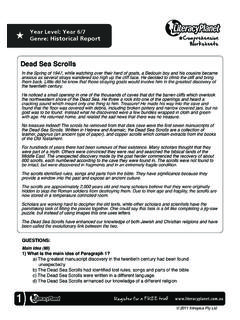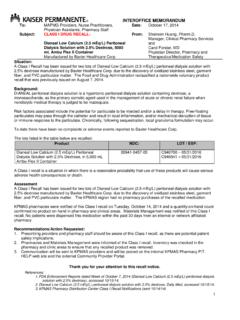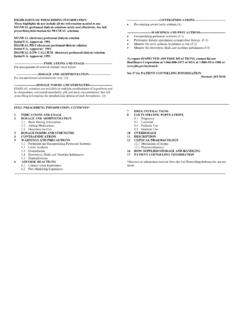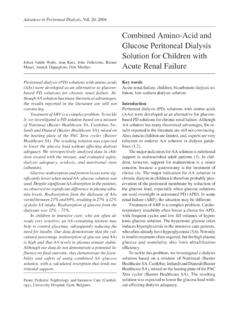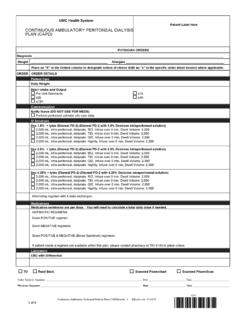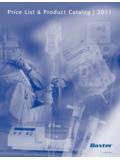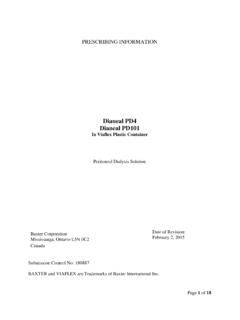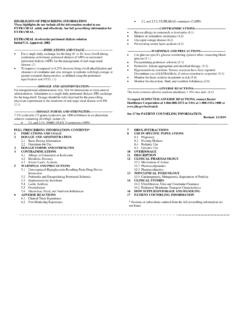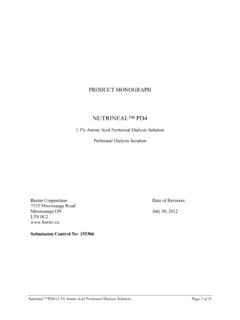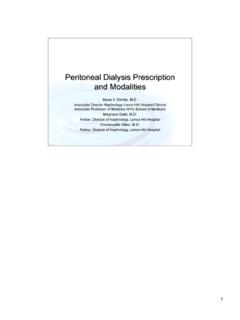Transcription of SOLUTION DIANEAL PERITONEAL DIALYSIS - …
1 DIANEAL PERITONEAL DIALYSIS SOLUTIONC onsumer Medicine InformationDIANEAL PERITONEAL DIALYSIS SOLUTIONP ublished by MIMS/myDr June 20171 What is in this leaflet?This leaflet answers some common questions about DIANEAL PERITONEAL DIALYSIS SOLUTION . It does not contain all of the available information. All medicines have risks and benefits. Your doctor has weighed the risks of you using DIANEAL PERITONEAL DIALYSIS Solutionagainst the benefit they expect it will have for does not take the place of talking to your doctor or you have any concerns about taking this medicine, ask your doctor or DIANEAL PERITONEAL DIALYSIS SOLUTION is used for?
2 Kidney failure occurs when the kidneys can no longer function adequately and a person s survival depends upon either a kidney transplant or renal replacement therapy, including is the process of filtering orcleansing the blood of waste products and excess water and removing them from the body. There are two methods of DIALYSIS treatment - haemodialysis and PERITONEAL DIALYSIS . Both employ specially formulated solutions to perform blood DIALYSIS uses the body's own PERITONEAL or abdominal membrane as a filter to cleanse the blood. The PERITONEAL membrane lines the PERITONEAL cavity. A sterile tube called a catheter is inserted by a simple surgical procedure throughthe wall of your abdominal cavity.
3 This provides an opening through which the DIALYSIS SOLUTION can be infused into the abdominal cavity. Waste products pass from the bloodstream, through the PERITONEAL membrane and into the DIALYSIS SOLUTION . Blood cells and large molecules such as proteins are retained since they are too large to pass through the membrane. The used DIALYSIS SOLUTION is periodicallydrained from the abdominal cavity and replaced with fresh SOLUTION , usually 3-4 times a DIALYSIS procedures are easy to learn but it is imperative thatyou adhere to the procedure taught by your health care are two ways of performing PERITONEAL DIALYSIS : Continuous Ambulatory PERITONEAL DIALYSIS (CAPD) or Automated PERITONEAL DIALYSIS (APD) ( , PERITONEAL DIALYSIS performed by a machine).
4 PD ( PERITONEAL DIALYSIS ) offers continuous self-care you use DianealPeritoneal DIALYSIS SolutionThe exchange procedure involves draining the used DIALYSIS SOLUTION containing the waste products, and instilling fresh SOLUTION into the PERITONEAL cavity. This must be performed with great care to avoid infection. The exchange procedure should be undertaken where there isprivacy and a clean, well-lit environment: home, office or bathroom. The environment should be clean, dust-free, ventilated but free from is important that the catheter exit site on the abdominal wall is kept clean and free from infection.
5 The catheter must be well-secured. To ensure this, you will be required to examine and cleanse your exit site daily. This must be done in the manner in which you were taught during your PERITONEAL DIALYSIS the product label for the correct volume, Glucose concentration and expiry integrity of the pack should be checked by squeezing the bag and examining carefully for signs of leakage. Ensure that the SOLUTION is to use DIANEAL PERITONEAL DIALYSIS SolutionThe single most important consideration in PD is asepsis, , maintaining very clean conditions during all procedures. While the exchange procedure is a simple technique to learn, it must be done with great care every time.
6 This isbecause there is always a risk that you may contaminate the SOLUTION and therefore cause an PERITONEAL DIALYSIS SOLUTIONP ublished by MIMS/myDr June 20172It will probably be necessary to warm CAPD solutions to body temperature before use. Specially designed thermostatically-controlled portable warming boxes are available for this purpose. Use of microwave ovens is not recommended because the product may be damaged, resulting in leakage and risk of APD the machine warms the SOLUTION to body temperature before it is installed in the PERITONEAL important points must be considered before and during use ofDianeal PERITONEAL DIALYSIS the solutions strictly in accordance with the instructions provided to you during your PERITONEAL DIALYSIS should dialyse only with the volume of SOLUTION and at thefrequency prescribed by your Kidney Doctor or your DIALYSIS the route of administration.
7 Please see Description and Use of PERITONEAL DIALYSIS solutions not use the SOLUTION unless it is clear and the seal is technique must be used all expected effects of DIALYSIS are correction of acid-base balance and electrolytedisturbances, fluid accumulation and removal of toxic waste products from the to perform DIALYSIS as ordered by your Kidney Doctor will result in rapid acid-base balance disturbances and fluid accumulation (which may result in pulmonary oedema and electrolyte imbalances includingraised serum potassium). This could cause a life-threatening of DIALYSIS must be in consultation with your Kidney Doctor or the Renal Unit or DIALYSIS accurate fluid balance recordmust be must check your weight regularly to avoid accumulating fluid in your will be required to have regular blood tests in order to monitor your should regularly visit your Kidney Doctor or the Renal Unitor DIALYSIS you are using DIANEAL PERITONEAL DIALYSIS SolutionDiscuss with your doctor or dialysisnurse the progress you have experienced during the treatment, whether any complication has occurred.
8 Especially during the first few days of therapy. Frequent clinical evaluation and laboratory tests may be effectsPatients using PERITONEAL DIALYSIS have experienced one or more of thefollowing unwanted effects: abdominal distension, loss of appetite, constipation, scrotal or labial swelling, backache, postural disturbances, pain on inflow and/or outflow, peritonitis (inflammation/infection of the PERITONEAL cavity), exit site infection, tunnel infection, muscle weakness and cramps. Any undesirable effect should be reported immediately to your Kidney Doctor or the Renal Unit or DIALYSIS case of OverdoseIf you accidentally infuse a larger volume of DIANEAL than prescribed by your Kidney Doctor, you may experience abdominal distension and pain.
9 If you exceed the number of exchanges prescribed, muscle weakness and cramps may occur. You should seek advice from your Kidney Doctor or the Renal Unit or DIALYSIS DescriptionsWhat DIANEAL PERITONEAL DIALYSIS SOLUTION looks like? DIANEAL PERITONEAL DIALYSIS solutions are supplied in either a single Viaflex plastic bag or a Freeline Solo Twin Bag ( SOLUTION bag with drainage bag attached).What is in DIANEAL PERITONEAL DIALYSIS SOLUTION ? DIANEAL PERITONEAL DIALYSIS Solutioncontains the following ingredients:Active Ingredients: Calcium Chloride Hexahydrate, Glucose Monohydrate, Magnesium ChlorideHexahydrate, Sodium Chloride, Sodium LactateInactive Ingredients: Water for Injections, Sodium Hydroxide, Hydrochloric AcidHow to store DIANEAL PERITONEAL DIALYSIS SolutionStore DIANEAL solutions under clean,dry conditions, protected from physical damage and at temperatures not exceeding 30 C.
10 However, individual bags may be warmed in a warming box to 38 C prior to use. Microwave ovens should not be used (see above). Theduration of warming an individual bag should not exceed 1 expiry date is located on the bottom right-hand corner of the label. solutions should not be used after the expiry date. DIANEAL SOLUTION should be clear. If it is not, DIANEAL PERITONEAL DIALYSIS SOLUTIONP ublished by MIMS/myDr June 20173do not use that bag; isolate it from your stock and return it to your DIALYSIS Centre. Do not use solutions from damaged can you get more information?Further information can be obtainedfrom your Kidney Doctor, or the Renal Unit or DIALYSIS Centre of thehospital which provided your PERITONEAL DIALYSIS and address of the SponsorManufactured by:Baxter Healthcare Pty Ltd1 Baxter DriveOld Toongabbie NSW 2146 AustraliaDistributed in New Zealand By:Baxter Healthcare Ltd33 Vestey DriveMount WellingtonAuckland 6 New ZealandThis Consumer Medicines Information Leaflet was revised June 2016


![[2014] FWCA 2812 - Amazon S3](/cache/preview/f/4/5/1/4/f/9/2/thumb-f4514f922951e1f35e0435b1bbf7687c.jpg)

